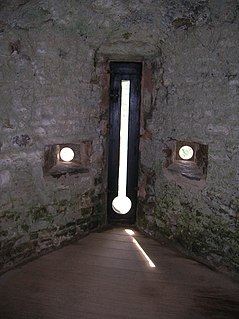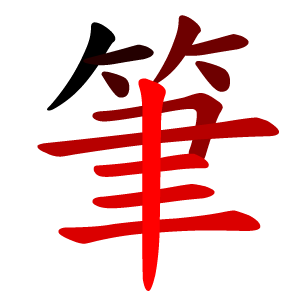
A door is a hinged or otherwise movable barrier that allows ingress (entry) into and egress (exit) from an enclosure. The created opening in the wall is a doorway or portal. A door's essential and primary purpose is to provide security by controlling access to the doorway (portal). Conventionally, it is a panel that fits into the doorway of a building, room, or vehicle. Doors are generally made of a material suited to the door's task. They are commonly attached by hinges, but can move by other means, such as slides or counterbalancing.

A rolltop desk is a 19th-century reworking of the pedestal desk with, in addition, a series of stacked compartments, shelves, drawers and nooks in front of the user, much like the bureau à gradin or the Carlton House desk. In contrast to these, the compartments and the desktop surface of a rolltop desk can be covered by means of a tambour consisting of linked wooden slats that roll or slide through slots in the raised sides of the desk. In that, it is a descendant in function, and partly in form, of the cylinder desk of the 18th century. It is a relative of the tambour desk, whose slats retract horizontally rather than vertically. The rolltop desk was re-invented by Jacob Alles in Jasper, Indiana in 1879. "About 1760 Jean-François Oeben designed a new type of bureau: the original rolltop desk. The writing area can be covered by a shutter made of flexible slats, which is rolled round a cylinder hidden behind the top tier of drawers. In the Château de Versailles is found the most famous example of this type of desk, the "bureau du roi," which was begun by Oeben in 1760 and finished by Riesener. Riesener made several rolltop desks; the one for Thierrry de Ville d'Avray indicates that the Louis XV style was not yet regarded as outmoded in the 1780s".

An embrasure is the opening in a battlement between the two raised solid portions, referred to as crenel or crenelle in a space hollowed out throughout the thickness of a wall by the establishment of a bay. This term designates the internal part of this space, relative to the closing device, door or window. In fortification this refers to the outward splay of a window or arrowslit on the inside.

Stroke order is the order in which the strokes of a Chinese character are written. A stroke is a movement of a writing instrument on a writing surface. Chinese characters are used in various forms in Chinese, Japanese, and Korean. They are known as Hanzi in (Mandarin) Chinese, kanji in Japanese (かんじ), and Hanja in Korean (한자).

A window blind is a type of window covering. There are many different kinds of window blinds which use a variety of control systems. A typical window blind is made up of several long horizontal or vertical slats of various types of hard material, including wood, plastic or metal which are held together by cords that run through the blind slats. Vertical blinds run along a track system which can tilt open and closed and move side-to-side. Window blinds can be manoeuvred with either a manual or remote control by rotating them from an open position, with slats spaced out, to a closed position where slats overlap and block out most of the light. There are also several types of window coverings, called shades, that use a single piece of soft material instead of slats.

In classical architecture, an architrave is the lintel or beam that rests on the capitals of columns.

The Cadillac Calais was the entry-level Cadillac model that was sold from 1965 to 1976. Cadillac renamed its low-priced Series 62 in 1965 as the "Calais", after the French port city of Calais that overlooks the narrowest point in the English Channel. In Greek mythology, Calais was one of two winged sons of Boreas, god of the North Wind, and Oreithyea. With the exception of no convertible model, the Calais shared the same styling and mechanics as the better-equipped, more expensive Cadillac de Ville.

Moulding, also known as coving(United Kingdom, Australia), is a strip of material with various profiles used to cover transitions between surfaces or for decoration. It is traditionally made from solid milled wood or plaster, but may be of plastic or reformed wood. In classical architecture and sculpture, the moulding is often carved in marble or other stones.

A mullion is a vertical element that forms a division between units of a window or screen, or is used decoratively. When dividing adjacent window units its primary purpose is a rigid support to the glazing of the window. Its secondary purpose is to provide structural support to an arch or lintel above the window opening. Horizontal elements separating the head of a door from a window above are called transoms.
In classical architecture, a tambour is the inverted bell of the Corinthian capital around which are carved acanthus leaves for decoration.

A wood shaper, usually just shaper in North America or spindle moulder in the UK and Europe, is a stationary woodworking machine in which a vertically oriented spindle drives cutter heads to mill profiles on wood stock. The wood being fed into a moulder is commonly referred to as either stock or blanks. The spindle may be raised and lowered relative to the shaper's table, and rotates between 3,000 and 10,000 rpm, with stock running along a vertical fence.
A triband is a vexillological style which consists of three stripes arranged to form a flag. These stripes may be two or three colors, and may be charged with an emblem in the middle stripe.

A slot antenna consists of a metal surface, usually a flat plate, with one or more holes or slots cut out. When the plate is driven as an antenna by an applied radio frequency current, the slot radiates electromagnetic waves in a way similar to a dipole antenna. The shape and size of the slot, as well as the driving frequency, determine the radiation pattern. Slot antennas are usually used at UHF and microwave frequencies at which wavelengths are small enough that the plate and slot are conveniently small. At these frequencies, the radio waves are often conducted by a waveguide, and the antenna consists of slots in the waveguide; this is called a slotted waveguide antenna. Multiple slots act as a directive array antenna and can emit a narrow fan-shaped beam of microwaves. They are used in standard laboratory microwave sources used for research, UHF television transmitting antennas, antennas on missiles and aircraft, sector antennas for cellular base stations, and particularly marine radar antennas. A slot antenna's main advantages are its size, design simplicity, and convenient adaptation to mass production using either waveguide or PC board technology.

Frame and panel construction, also called rail and stile, is a woodworking technique often used in the making of doors, wainscoting, and other decorative features for cabinets, furniture, and homes. The basic idea is to capture a 'floating' panel within a sturdy frame, as opposed to techniques used in making a slab solid wood cabinet door or drawer front, the door is constructed of several solid wood pieces running in a vertical or horizontal direction with exposed endgrains. Usually, the panel is not glued to the frame but is left to 'float' within it so that seasonal movement of the wood comprising the panel does not distort the frame.

Framing, in construction, is the fitting together of pieces to give a structure support and shape. Framing materials are usually wood, engineered wood, or structural steel. The alternative to framed construction is generally called mass wall construction, where horizontal layers of stacked materials such as log building, masonry, rammed earth, adobe, etc. are used without framing.

Many East Asian scripts can be written horizontally or vertically. Chinese, Japanese, Vietnamese Hán-Nôm and Korean scripts can be oriented along either axis, as they consist mainly of disconnected logographic or syllabic units, each occupying a square block of space, thus allowing for flexibility for which direction texts can be written, be it horizontally from left-to-right, horizontally from right-to-left, vertically from top-to-bottom, and even vertically from bottom-to-top.
This page is a glossary of architecture.
Ventilation is a part of structural firefighting tactics, and involves the expulsion of heat and smoke from a burning building, permitting the firefighters to more easily and safely find trapped individuals and attack the fire. If a large fire is not properly ventilated, not only will it be much harder to fight, but it could also build up enough poorly burned smoke to create a smoke explosion or enough heat to create a flashover. Contrarily, poorly placed or timed ventilation may increase the fire's air supply, causing it to grow and spread rapidly. The flashover may cause the temperature inside the building to peak at over 1,000 °C (1,830 °F).

The Edisen Fishery is a fishery located in Rock Harbor in the Isle Royale National Park in Michigan. It was designated a Michigan State Historic Site in 1976 and listed on the National Register of Historic Places in 1977.
In astronomy, geography, and related sciences and contexts, a direction or plane passing by a given point is said to be vertical if it contains the local gravity direction at that point. Conversely, a direction or plane is said to be horizontal if it is perpendicular to the vertical direction. In general, something that is vertical can be drawn from up to down, such as the y-axis in the Cartesian coordinate system.















